its paid sponsors, whose products you need!
| Home |
| Intro |
| Current Issue |
|
Mailing List |
| Store |
| Strength |
| Subscriber Content |
| ARCHIVES
|
| Martialism |
| Pacifism |
| Q & A |
| Cunning-Hammery |
| Advertise With Us |
| Submit An Article |
| Staff |
| Discussion Forum |
| Links |
“Stay ‘unreasonable.’ If you
don’t like the solutions [available to you], come up with your
own.”
Dan Webre
The Martialist does not
constitute legal advice. It is for ENTERTAINMENT
PURPOSES ONLY.
Copyright © 2003-2004 Phil Elmore, all rights
reserved.
Hanwei Practical Katana
A Product Review by Phil Elmore
There was a time when I once thought of two blades as
essential for the “martial artist.” The balisong I considered, in my
youthful exuberance, the must-have sidearm of the modern-day samurai.
This implied, at least to me, that the modern traditionalist warrior’s “assault
weapon” would have to be the “samurai sword” the Japanese katana. The
first set of swords I ever owned more appropriately termed sword-like
objects were gaudy aluminum decorator models with some sort of
horrible orange finish. I didn’t know any better and it would be some
time before I realized that all the stainless steel Highlander: The Series
katanas in the world did not constitute viable weaponry.
Over the years I’ve not lost my taste for balisongs or for
swords, but I’ve learned to keep these things in perspective. Thus it
was with great anticipation tempered with realism that I drove to my Kung Fu
school one night to pick up an item I’d ordered through my teacher.
After excruciating weeks of backorders and shipping delays, my Hanwei katana
had finally arrived.

The author and his Hanwei Practical Katana a
reliable, effective weapon.
I must state at the outset that I am not primarily a student
or stylist of the Japanese sword. I am a pragmatist when it comes to
weapons; I believe in seeing the commonality in all weapons of like type
and I use them accordingly without regard to tradition or lineage. Of
the weapon arts in which I’ve dabbled or actively studied, the one in which I
have the most experience is FMA (Kali). I don’t believe sword work need
be any more complicated than getting the pointy end in the other man, provided
your body mechanics are sound and you understand how to move the weapon to
employ its cutting edge and to block with its flat. I hope those of you
who are traditionalist budoka focusing on the sword will forgive
me my expedience and my pragmatism; I mean no disrespect and I certainly
make no claims to being one of you.

The Hanwei Practical Katana ships with this nice
cloth bag to protect the sword.
I will also state up front that as of this writing, I have
tested my Hanwei katana for five months, cutting a variety of contemporary
(non-traditional) media such as cardboard, plastic, and light scrub outdoors.
The sword has not failed me and has suffered no visible damage. It’s my
understanding that some demanding users have found the handle wrap of the
sword less than durable enough for their needs, but I have had no difficulties
with mine (and would simply have searched out the proper techniques for
rewrapping it if I had). I have wielded the sword in solo practice and
found it the right blade for me at this time the right blend of size,
balance, and yes, I’ll say it style for me. Perhaps it is
fitting that I, who study a Chinese martial art, would choose a Japanese-style
sword made in China.
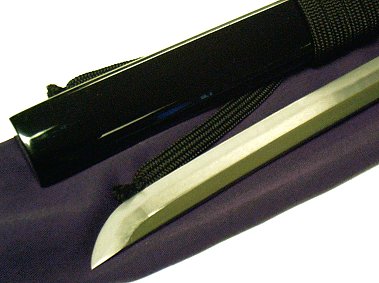
The blade and scabbard sitting on the purple sword
bag.
What this sword is not is an expensive traditional
blade. It is a no-frills weapon intended to look like what most
people think of when they think of a “samurai sword.” I’m not going to
bother with traditional terminology here, because those who know their katanas
will not be impressed and those who do not will find the references needlessly
confusing. For our purposes, a blade is a blade, a guard is a
guard, and a scabbard is a scabbard.
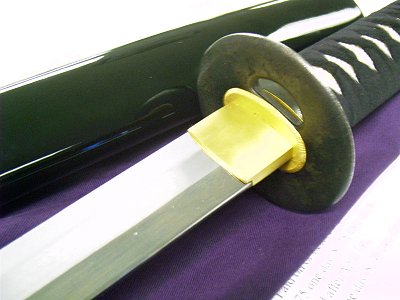
The blade has a “deep” feel and showed a few scuff
marks out of the box.
My Hanwei Practical Katana shipped to me complete with a
protective purple cloth bag. It has a 28¼-inch
blade of differentially tempered high-carbon steel. The edge is hardened
to HRC60, while the spine is HRC40. The handle is 11¾ inches,
making the weapon 40 inches overall. In my bare feet with my elbow
slightly bent, the blade just clears the floor, making the sword perfect for
my six-foot height.
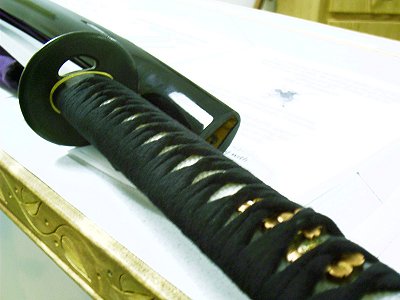
Stylized wrap has a soft, velvet-like feel that I
found comfortable.
Fit and finish of the sword are consistent with a functional
but affordable import blade of this type. The blade’s temper line is
visible and the steel itself has the depth and grain* that sets good steel
apart from cheap, poorly heat-treated junk (or, for that matter, the stainless
blades of decorator swords). Mine shows more than a few small scuffs and
blemishes that it had out of the box.
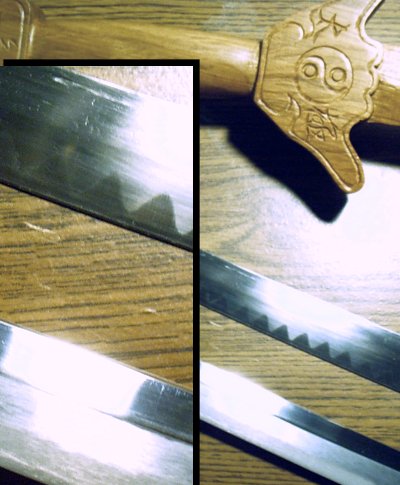
Practical Katana (bottom in photo and in inset) has
what I
would
call “depth” and “grain” not found on cheap junk sword
(top) though
I am using these terms to
describe quite subjectively the “visual feel”
of the metal and not in the metallurgical or technical senses.
The rest of the fittings are
similarly workmanlike; the brass collar is smooth but a little scuffed,
the plain metal guard has a rough, rugged, uneven finish, and the pebbled “rayskin”
under the handle wrap is a little ragged around the pins. The
copper-colored metal flowers under the wrap I find quite attractive in their
contrast with the handle. The metal fittings at the top and bottom of
the handle are similar in appearance to the guard.
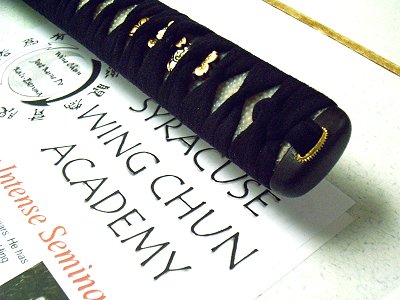
The handle of the Practical Katana is actually quite
attractive.
The scabbard is
nicely finished and fits the sword snugly not too tightly, not too loosely.
I am happy with the draw. The nub to which is mounted a length of flat
nylon cord is lined with cheap plastic colored to look like brass; these
can be plucked out and will fall out on their own.
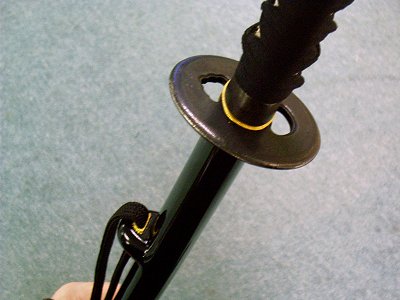
Brass-colored plastic liner (lower left) will fall
out on its own at times.
The sword handles well. I find it neither too heavy
nor too light, but I am not a traditionalist iaidoka or kendoka,
so others may not share this opinion. Point of balance seems to be about
5
½ inches above the guard.
On the evening my sword arrived, I was not scheduled to
train, but I often hang around the school on my free nights. In this
case I went specifically to get my blade. When I picked it up, I spent
some time admiring it and making sure it had no obvious problems before Sifu
brought one of the long cardboard sword boxes out from the back room.
“Want to try a cut?” he asked.
Suddenly, it was very quiet. Sifu has been trying to
make the nickname “Blade” stick to me for at least the last year. My
fellow students looked at me expectantly, some of them probably considering
this. I regarded the box. Standing freely on its open end, it
would make a challenging target. If I did it wrong, I’d have a box with
a slash in its surface simply flying across the room.
I took a few practice half-swings, breathed deeply, and…
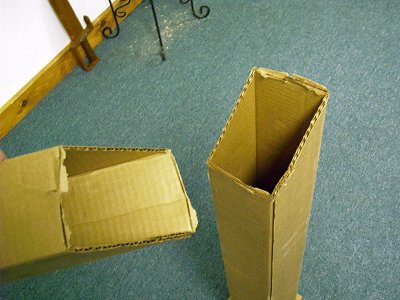
The Hanwei Practical Katana neatly sliced this
free-standing, empty box.
…looked down after following through with my cut, my eyes
widening at the neatly severed box top at my feet.
“I, er, meant to do that,” I said.

Immediately after the box-cutting incident, a story
much repeated
at our kwoon in the days that followed that notable evening.
Sifu had occasion to offer his own perspective on the event
some time later at The Martialist‘s official discussion forum,
Pax Baculum. He
owns an identical Hanwei katana that was part of the same batch in which mine
was shipped.
I was present when Phil made that cut and was impressed with how smooth and clean
his technique was. [Not long afterward] I handed someone my sword and asked
[him]
to do the same cut Phil did. Now mind you… this guy is known for his ability
with knives, sticks and machetes… but his cut was not as good as Phil’s.
Now, yes, I’m indulging myself in some self-congratulation,
but to be honest this little kwoon anecdote would not have gone in my favor
with a lesser sword. The Practical Katana was nicely sharp out of the
box and has proven to be a very functional blade.
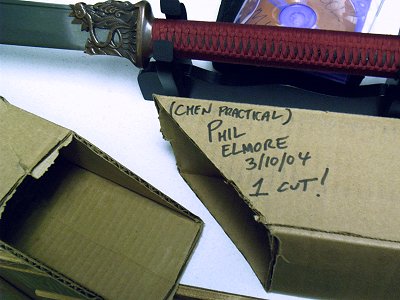
I am pleased with my purchase of this Hanwei product.
My needs are not those of traditionalist Japanese swordsmen, but neither are
they undemanding. For the cost, this is a decent, functional sword whose
value meets its price in my eyes.
I think that’s the definition
of “practical.”
* Added technical disclaimer thanks to input from Chris
Moses.
